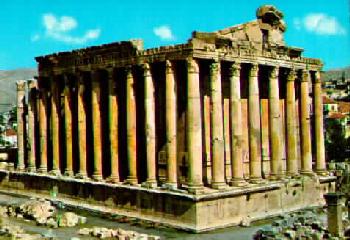|
||||||
Culture
Lebanon has a lively arts scene, both traditional and contemporary. The national dance, the dabke, is an energetic folk dance. Classical belly dancing still plays an important role at weddings, representing the transition from virgin bride to sensual woman, and is also popular in nightclubs. Traditional Arabic music is created using unharmonised melodies and complex rhythms, often accompanied by sophisticated, many-layered singing. Instruments used include the oud, a pear-shaped string instrument; the tabla, a clay, wood or metal and skin percussion instrument; the nay, a single reed, open-ended pipe with a lovely mellow tone; and the qanun, a flat trapezoid instrument with at least 81 pluckable strings.
Literature and poetry have always had an important place in Lebanese culture. One very popular form of poetry is the zajal, in which a group of poets enter into a witty dialogue by improvising verses to songs. The most famous Lebanese literary figure is Khalil Gibran, a 19th-century poet, writer and artist whose work explored Christian mysticism. Contemporary writers include Amin Maalouf, Emily Nasrallah and Hanan Al-Shaykh.
|
|
|
About 60% of Lebanon's population is Muslim and 40% is Christian. The largest Muslim group is the Shiite (Shia) sect, followed by the Sunni and the Druze. The Druze are one of the religious curiosities of the Middle East. Originally an offshoot of Islam, they have diversified so much from the mainstream that they are often considered to constitute a whole separate religion. The Druze believe that God incarnated himself in men at various times and that his last, and final, incarnation was Al-Hakim bi Amrillah, the sixth Fatimid caliph who died in 1021 AD. They believe in reincarnation and that there are a fixed number of souls in existence. Druze gather for prayer meetings on Thursday evenings in inconspicuous halls; outsiders are not permitted to attend and the rites remain highly secretive. The largest Christian group is the Maronite sect, followed by the Greek Orthodox, the Greek Catholic, the Syrian Catholic, the Chaldean, the Protestant and the Orthodox churches.
Arabic and French are the official language of Lebanon although Arabic is by far the most widely spoken and English is becoming common in business circles. Arabs place great importance on civility and it's rare to see any interaction between people that doesn't begin with profuse greetings, enquiries into the other's health and myriad niceties. As an ajnabi (foreigner), you're not expected to know all the ins and outs, but if you make the effort to come up with the right expression at the appropriate moment, you'll be respected for it. In fact, any effort to communicate with the locals in their own language will be well rewarded. No matter how far off the mark your pronunciation or grammar might be, you'll often get the smiling response 'Ah, you speak Arabic very well!' Lebanese cuisine is an inexpensive delight. Using fresh and flavoursome ingredients and refined spicing, the Lebanese have taken the best aspects of Turkish and Arabic cooking and given them a French spin. A typical meal consists of a few mezze dishes, such as spinach pies, dips, dried cheese, pizza and stuffed vine leaves. This is followed by a main dish of meat (usually mutton) or fish, often stuffed with rice and nuts, plus a salad such as tabouleh or fattoush. The national dish is kibbeh, a finely minced paste of lamb and bulgur wheat, sometimes served raw, but more often fried or baked into a pie. Meals are rounded off with syrupy baklava pastries or other semolina and walnut-based desserts.
Arabic coffee is very popular. Soft drinks include jellab, a delicious drink made from raisins and served with pine nuts, and ayran, a yoghurt drink. Alcohol is cheap and widely available; the most popular manifestation is arak, which is mixed with water and ice. |
|

